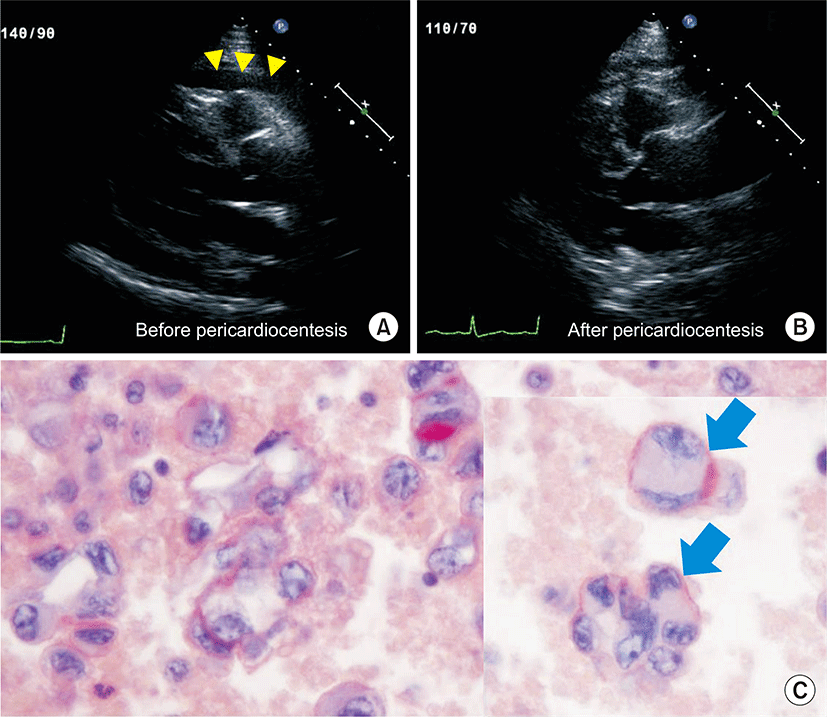Introduction
The metastatic pericardial effusion (PE) with or without hemodynamic compromise in advanced cancer is common. PE as the first manifestation of unrecognized cancer, however, is uncommon [1]. Clinical presentations of metastatic PE are various from silence to sudden death [2]. Pericardial drainage is considered as an important diagnostic and therapeutic option in the symptomatic patients with large amount of PE. For small amount PE with unclear etiology and no definite symptoms, on the other hand, physicians tend to be reluctant to perform pericardiocentesis because of the procedure related complications such as myocardial injury, pneumothorax, and liver injury [2]. Early invasive pericardial drainage, however, might be helpful to detect hidden malignancy in this clinical situation. Hereby, we report the prognostic effects of early detection of adenocarcinoma of unknown primary origin (ACUP) by the prompt and careful pericardiocentesis in the patient with small amount pericardial effusion of unknown etiology as the initial manifestation.
Case
A 65-year-old woman presented with mild dyspnea for two weeks. She denied any past medical history. The chest X-ray showed mild cardiomegaly with increased vascular markings. The initial echocardiography revealed circumferential echo-free space of 1.1 cm depth around the heart suggesting PE with slight diastolic collapse of the right ventricular free wall. The chest computed tomography (CT) likewise showed circumferential PE and 1 cm-sized right lower paratracheal multiple lymph nodes without any other abnormal findings. A very careful pericardiocentesis was carried out under the both echo and fluoroscopy guidance in order to avoid myocardial injury during the procedure considering the narrow pericardial space to drain (Fig. 1A, B). Her dyspnea slightly improved after the procedure. The biochemical laboratory exam of the pericardial drainage reported that lactate dehydrogenase fluid/serum ratio of 3.3 and the CEA level of 68.7ng/ml. The microbial study such as AFB staining was all negative. Cytological study using cytospin and cell-block demonstrated malignant cells consistent with metastatic adenocarcinoma (Fig. 1C). Other pathological stains including CEA, Leu-M1 etc. were negative except for only HER2 and TTF-1. We could rule out mesothelioma on the base of negative results of p63, D2-40, and calretinin with positive result of mucicarmine staining. Any other metastatic origin was not found despite of the meticulous examinations such as chest and abdominopelvic CT, mammography, thyroid and breast ultrasonography, whole body positron emission tomography, and gastrointestinal endoscopies. Therefore, the patient underwent immediate palliative chemotherapy with the empirical regimen including cisplatin and taxol for lung and breast cancer four times under the diagnosis of ACUP. Regular follow-up of echocardiography and chest and abdominal CT in six and twelve months found only minimal residual PE without any mass like lesion.
The patient had survived for 15 months without any evidence of recurred adenocarcinoma until she died from asphyxia during night sleep. The primary site of malignancy had not been found to her last breath.
Discussion
Although the large amount metastatic PE in known advanced cancer is commonly detected, small amount of PE due to ACUP as the first manifestation of malignancy is not common [1]. As for the unclear etiology of PE, lung cancer is known as the most common primary source (up to 58%) and followed by breast cancer, thyroid cancer, lymphomas, and leukemia [2]. Clinical presentations of malignant PE are various from silence to sudden death according to the clinical situations. When symptoms are not typical and the amount of PE is relatively small, physicians often delay the invasive percutaneous or surgical drainage in order to avoid procedure related complications such as myocardial injury, pneumothorax, and liver injury [2]. In some cases presenting with acute pericarditis or tamponade with no apparent cause, an initial empirical anti-inflammatory therapy is recommended. If no adequate response is followed even after the empirical treatment, then pericardiocentesis and/or pericardial biopsy would be performed. Delayed drainage procedure due to any cause might delay the diagnosis of hidden malignancy. The drained malignant PE is associated with the tumor markers such as CEA, CA 72-4, and CA 19-9. The cytological and immunohistochemical studies are useful in delineation of the primary origins of the tumor cells [3]. In our case, we could not completely rule out the primary origin of lung malignancy because some immunohistochemical staining including TTF-1 were positive.
Evidence of tamponade, larger effusion volumes, and positive cytological findings are associated with poor prognosis with a mean survival of 2.8±1.3 months in a literature [4].
To our knowledge, our patient showed relatively good survival compared to other patients with metastatic PE, thus implicating an educational value. When the patient presented with mild dyspnea, immediate echocardiography demonstrated small amount of PE as the first manifestation of malignancy. Although the etiology of PE was not clear and the invasive drainage procedure could be dangerous considering safety margin due to small amount of PE, the prompt and careful pericardial drainage without delay from hesitancy due to probability of procedure related risks or from wasting time for empirical anti-inflammatory therapy enabled us to early detect hidden ACUP. A complete drainage also might have enabled early removal of apparent tumor burden, thereby yielding better survival [5].
